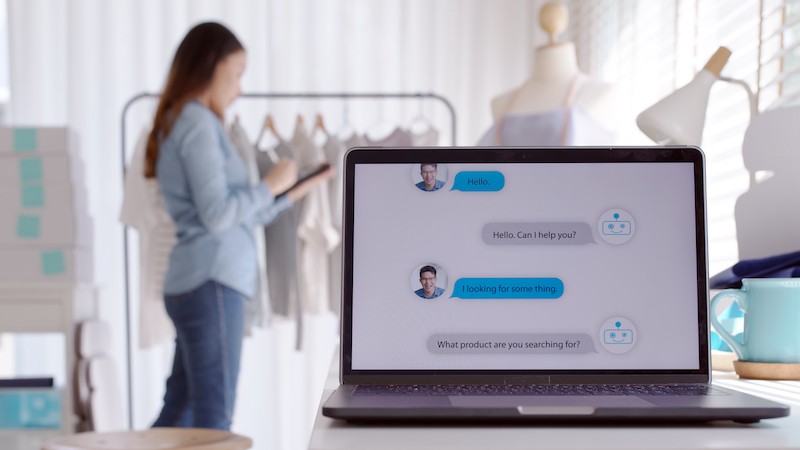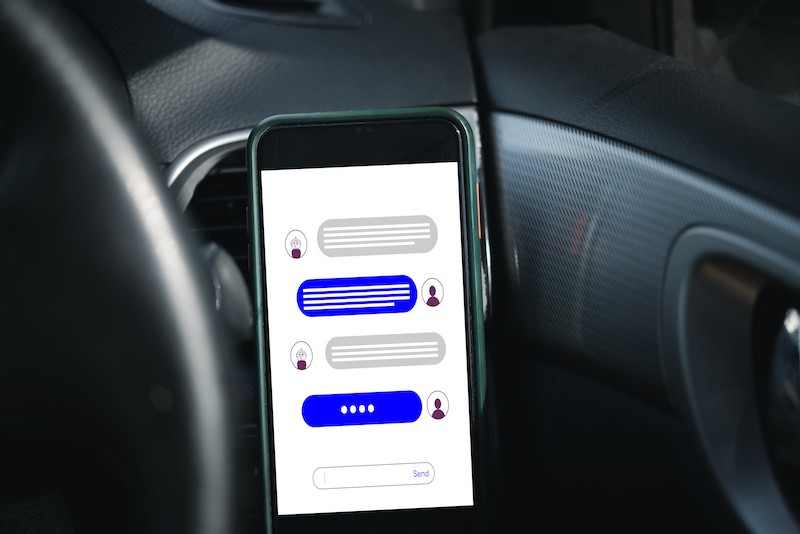Right now, artificial intelligence (AI) is getting a lot of bad press. There have been news reports that AI can pass medical exams, has threatened to destroy humanity, and even more. However, AI isn’t new in any way. It’s actually been around for years. One example of common AI is chatbots. You’ve seen them for years on websites, usually in the bottom left or right corner. You’ve probably developed a love/hate relationship with them.
We understand. Chatbots, at their worst, can be annoying. But at their best, they are effective ways to make sure you never miss a lead and also save your employees time when it comes to directing inquiries.
Table of Contents
What Is a Chatbot?
A chatbot is a computer code that uses AI and natural language processing (NLP) to understand questions customers enter into a chat box. Then, it either gives them responses or kicks them up to the next layer of assistance. Chatbots can make it easy for customers to find the information they need by responding to their questions. The responses can include links to where they can find the information they need or phone numbers, for example. Chatbots don’t have to require that a person actually types anything. Advanced chatbots understand audio requests or prompts.
Chatbots are almost everywhere today, and even if you dislike them, think of a time when they came in useful. After all, do you really want to call the cable company? Or was their live chat feature more convenient? A live chat feature starts with chatbot technology. Before you are connected with a real person, the AI tool uses NLP to try to address your needs.
According to Salesforce, 23% of customer service companies are currently using AI chatbots. Because chatbots took a beating in the press, the latest AI chatbots are often referred to as “virtual assistants.” Chatbots aren’t just for websites. They are used on phones and in-home smart devices. Some examples you are probably familiar with include Apple’s Siri, Google Assistant, and Amazon Alexa. Yes, that’s right. Alexa is an advanced chatbot. Now, you may not need an Alexa-level chatbot for your business, but they can be helpful so that you don’t miss a lead.
How Do Chatbots Work?
Historically, chatbots were text-based. Users would go to a website, type in a question, and receive a programmed reply that had been pre-written by the chatbot’s developers. After all, just like in brick-and-mortar businesses, customers tend to ask the same questions over and over. Rather than make a real person answer every single online chat question, a chatbot can handle questions about returns, store hours, shipping, and more. But then, when people asked unexpected questions, they had to upgrade the technology.

How Have Chatbots Changed?
Over time, chatbots have integrated more best practices and become more advanced. In fact, the latest types of chatbots can respond right away to requests like “Agent please.” This technology used to annoy people but as it has improved, peoples’ perceptions about it continue to improve. Now, studies show that around 90% of consumers’ experiences with chatbots are either neutral or positive.
Today’s AI chatbots use natural language understanding to figure out what the person needs and wants. These advancements rely on machine learning to develop an increasingly advanced knowledge base of questions and responses that are based on user experiences. In other words, they can accommodate users who get frustrated. For example, if a user asks about tomorrow’s temperature, a traditional chatbot can respond with the exact degree. An AI chatbot, however, might also ask if the user wants to know about rain.
What Are The Differences Between Chatbots vs AI Chatbots vs Virtual Agents?
You may notice the terms chatbot, AI chatbot, and virtual agent being used synonymously.
However, it is worth noting that the learning capabilities of AI chatbots enable interactions to become more accurate over time, building a web of appropriate responses via their interactions with humans. Chatbots are not able to do that. They just remain the same, since they have no ability to learn. Meanwhile, the longer an AI chatbot has been in operation, the stronger its responses become.
Why Invest in Chatbots?
The latest AI chatbots can respond to customers immediately. They can also save a customer’s information, like a phone number or email, so you can get back to them later if a live agent isn’t available.
Chatbots solve all kinds of issues related to customer service departments. In fact, according to a report published by Com100, chatbots are capable of handling full conversations with customers almost 70% of the time. Meeting the demand and training staff to provide consistent replies to similar or repetitive queries, day or night, is a waste of time and energy for many companies. Chatbots free up employees from repetitive tasks. They also humans to deal with higher-level customer inquiries and complaints that AI can’t solve. A chatbot can also eliminate long wait times for phone-based customer support. Happy customers = more sales and brand loyalty.

How Do I Get a Chatbot Onto My Website?
Most website builders and content management systems have a chatbot plugin or third-party widget to install on your website. You definitely want whichever chatbot you use to be fast. According to Userlike, 68% of users enjoy the speed that comes with using chatbots, especially how quickly they receive a response. So, don’t get a chatbot that’s slow to load.
If you have a WordPress site, there are a number of options, from ZenDesk to Chatbot. Each comes with its own pros and cons as well as costs. The cost will increase as your needs become more advanced and the more languages you want to offer responses in. Video chats are also available, for increased fees. For a Wix site, Wix Chat is included with paid plans. You must design the chatbot a bit, but it’s pretty easy to navigate. Shopify also offers free and paid chatbots.
Questions to Consider When Choosing a Chatbot
- Who calls or asks the most questions via online forms or in person at my store?
- What problems are they facing?
- What benefits and/or solutions does the chatbot offer?
- Can my current staff respond to chat inquiries?
- Do I want live agents available 24/7?
- Do I want people waiting for an agent to see anything, get coupons, have the ability to sign up for newsletters or more?
- Do my customers have audio or visual impairments?
- What languages do my customers speak?
- What do I want the chatbot to respond with?
How We Can Help With Chatbots
SEO Design Chicago can help you determine what your best option is for having a chatbot on your website. For some, simple text-based chatbots will suffice. For others, sales can be boosted by making sure your chatbot can understand audio and video, and return information in a variety of languages. Some chatbots will even offer product suggestions or coupons while a person waits to be connected to a live agent. You can also encourage those who are waiting to rate your chatbot so that you can make improvements to it moving forward.
Our experienced team is happy to help you get started, or evaluate your current chatbot, so you can improve your company’s customer service capabilities.
FAQ:
- What is a chatbot?
- How do chatbots work?
- Why are chatbots beneficial for businesses?
- How do you decide on the right chatbot?
- Are chatbots, AI chatbots, and virtual assistants the same thing?



Contact Us Today!